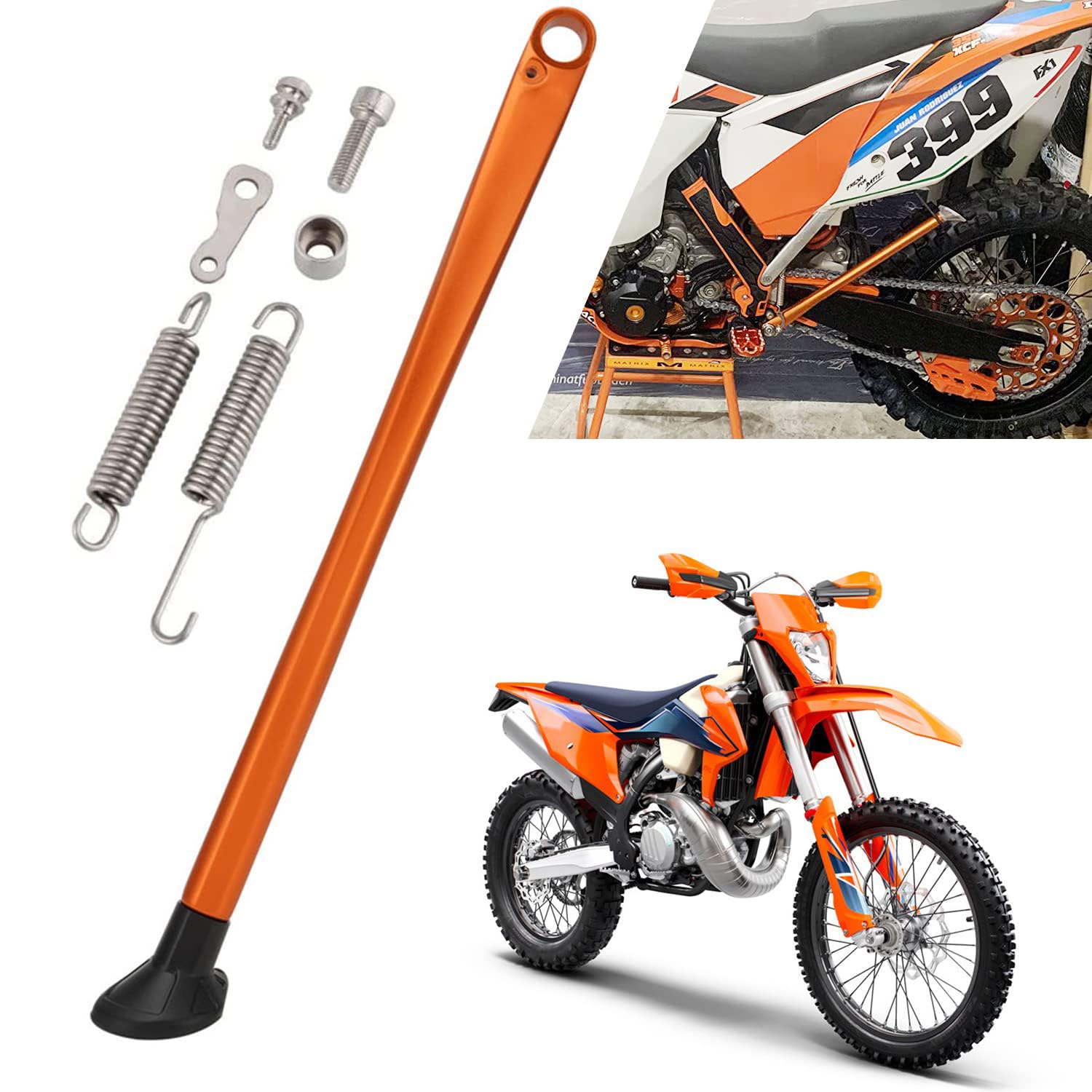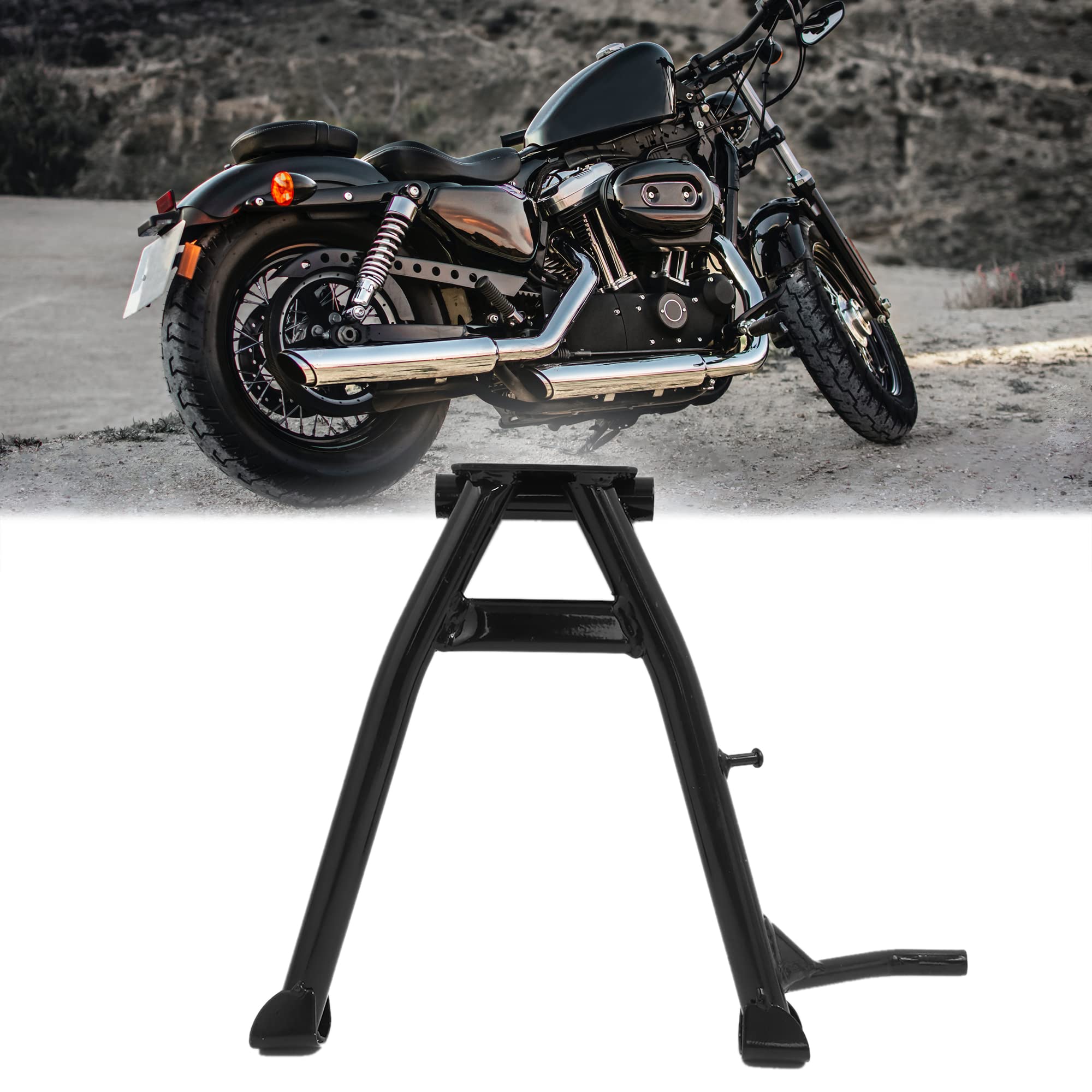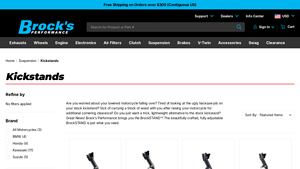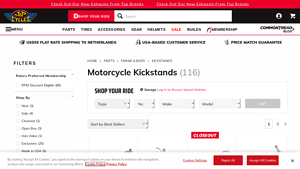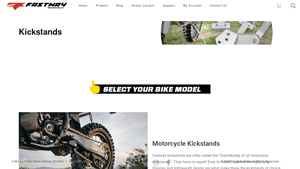Motorcycle Kick Stands Guide: Type, Cost, Top List…
Introduction: Navigating the Global Market for motorcycle kick stands
In the dynamic world of motorcycle accessories, sourcing high-quality motorcycle kickstands can pose significant challenges for international B2B buyers. Ensuring that these essential components not only meet safety standards but also align with diverse regional preferences can be daunting. This guide aims to streamline the procurement process by providing a comprehensive overview of various kickstand types, their applications, and the critical factors to consider when selecting a reliable supplier.
We delve into the nuances of kickstand design, including adjustable models for customized fitment, weld-on options for custom builds, and lightweight alternatives for performance motorcycles. By examining the cost structures associated with different types and brands, buyers can make informed decisions that cater to their specific market needs, whether they are operating in Africa, South America, the Middle East, or Europe, including countries like Saudi Arabia and Vietnam.
Furthermore, this guide emphasizes the importance of supplier vetting, offering practical insights on how to identify reputable manufacturers and distributors. By empowering B2B buyers with actionable knowledge and resources, we facilitate strategic purchasing that enhances operational efficiency and product quality in the competitive motorcycle market. Understanding these elements will not only mitigate risks but also foster long-term partnerships that are crucial for success in the global marketplace.
Understanding motorcycle kick stands Types and Variations
| Type Name | Key Distinguishing Features | Primary B2B Applications | Brief Pros & Cons for Buyers |
|---|---|---|---|
| Standard Kickstands | Fixed height, typically made of steel or aluminum. | OEM replacements for various motorcycle models. | Pros: Cost-effective, widely available. Cons: May not accommodate customizations. |
| Adjustable Kickstands | Height can be modified for different bike configurations. | Custom motorcycle shops, performance upgrades. | Pros: Versatile, accommodates modifications. Cons: Higher cost, complex installation. |
| Weld-On Kickstands | Permanently attached to the motorcycle frame, custom-built. | Custom chopper and bobber builders. | Pros: Strong, tailored to specific designs. Cons: Requires welding expertise, permanent. |
| Center Kickstands | Positioned centrally, providing stability on uneven ground. | Touring motorcycles, heavy bikes. | Pros: Enhanced stability, easy to deploy. Cons: Heavier, may require additional space. |
| Side Kickstands | Traditional design, mounted on the side of the bike. | General motorcycle use, aftermarket sales. | Pros: Simple design, easy to use. Cons: Can be less stable on uneven surfaces. |
What Are Standard Kickstands and Their B2B Relevance?
Standard kickstands are the most common type found on motorcycles, typically crafted from durable materials like steel or aluminum. These kickstands are designed to support the motorcycle in an upright position when parked. B2B buyers often seek standard kickstands for original equipment manufacturer (OEM) replacements, as they are widely available and cost-effective. However, their fixed height means they may not be suitable for modified or lowered bikes, limiting their versatility in custom applications.
How Do Adjustable Kickstands Benefit Custom Motorcycle Shops?
Adjustable kickstands offer the flexibility to modify the height, making them ideal for various motorcycle configurations. These kickstands are particularly beneficial for custom motorcycle shops that cater to clients looking for performance upgrades or unique designs. While they provide versatility and can accommodate modifications, buyers should consider the higher cost and potentially complex installation process, which may require professional assistance.
What Are the Advantages of Weld-On Kickstands for Builders?
Weld-on kickstands are custom-built and permanently attached to the motorcycle frame, making them a popular choice for custom chopper and bobber builders. These kickstands are designed for strength and tailored to specific bike designs, offering a clean aesthetic. However, they require welding expertise for installation, making them less accessible for casual buyers. Their permanence means they are not suitable for those who may want to change their bike’s configuration in the future.
Why Choose Center Kickstands for Touring Motorcycles?
Center kickstands are strategically positioned to provide enhanced stability, especially on uneven ground, making them ideal for touring motorcycles or heavier bikes. B2B buyers in the touring segment appreciate the ease of deployment and the added stability these kickstands offer during stops. However, they tend to be heavier than side-mounted options and may require additional space, which could be a consideration for those with limited storage.
What Should Buyers Consider About Side Kickstands?
Side kickstands are the traditional choice for most motorcycles, mounted on the side to allow for easy deployment. They are simple in design and user-friendly, making them a staple in general motorcycle use and aftermarket sales. However, buyers should be aware that side kickstands can be less stable on uneven surfaces, which may pose a risk in certain environments. For businesses catering to a diverse range of motorcycle types, offering a mix of side and other kickstand variations can meet various customer needs.
Key Industrial Applications of motorcycle kick stands
| Industry/Sector | Specific Application of motorcycle kick stands | Value/Benefit for the Business | Key Sourcing Considerations for this Application |
|---|---|---|---|
| Motorcycle Manufacturing | Integration into production lines for assembly | Streamlined assembly processes, improved safety | Material quality, compliance with industry standards |
| Custom Motorcycle Shops | Custom fabrication for unique bike designs | Enhanced product offerings, customer satisfaction | Customization capabilities, lead times, and pricing |
| Motorcycle Rentals and Tours | Durable kickstands for fleet maintenance | Reduced operational costs, increased reliability | Durability, maintenance support, bulk purchasing options |
| Automotive Aftermarket | Replacement parts for motorcycle maintenance | Increased sales opportunities, customer loyalty | Compatibility with various models, warranty options |
| Export and Import Businesses | Sourcing for international distribution | Access to diverse markets, competitive pricing | Shipping logistics, import/export regulations, supplier reliability |
How are motorcycle kick stands used in motorcycle manufacturing?
In the motorcycle manufacturing sector, kick stands are integrated into production lines to facilitate the assembly process. By providing a stable support for motorcycles during assembly, these kick stands enhance safety and efficiency. Manufacturers often seek high-quality materials to ensure durability and compliance with industry standards. For international buyers, particularly from regions like Africa and South America, understanding the local regulations regarding manufacturing components is crucial for successful sourcing.
What role do custom motorcycle shops play in the application of kick stands?
Custom motorcycle shops utilize kick stands to fabricate unique designs tailored to customer specifications. These shops often require kick stands that not only function effectively but also complement the aesthetic of custom builds. The ability to customize kick stands can significantly enhance product offerings, leading to higher customer satisfaction. Buyers must consider the customization capabilities of suppliers, including lead times and pricing, to ensure they meet client demands efficiently.
How do motorcycle rentals and tours benefit from using kick stands?
Motorcycle rentals and tour operators rely on durable kick stands to maintain their fleets. These kick stands must withstand frequent use and varying environmental conditions, ensuring reliability and reducing operational costs related to maintenance. By investing in high-quality kick stands, rental businesses can enhance their service offerings and ensure customer safety. Key sourcing considerations include durability and the availability of maintenance support, which are vital for keeping fleets operational.
What are the considerations for the automotive aftermarket regarding kick stands?
In the automotive aftermarket, kick stands serve as replacement parts for motorcycle maintenance. Retailers and distributors can benefit from offering a range of kick stands compatible with various motorcycle models, thus increasing sales opportunities. Building customer loyalty is critical in this sector, and offering warranties can be a significant selling point. Buyers should focus on compatibility with multiple models and consider warranty options to reassure their customers of product reliability.
Why is sourcing motorcycle kick stands essential for export and import businesses?
Export and import businesses play a vital role in the global distribution of motorcycle kick stands. Sourcing these components from reliable manufacturers allows businesses to access diverse markets and offer competitive pricing. Understanding shipping logistics and navigating import/export regulations are essential for successful transactions. For international buyers, especially in regions like the Middle East and Europe, establishing strong relationships with suppliers can facilitate smoother operations and enhance supply chain efficiency.
3 Common User Pain Points for ‘motorcycle kick stands’ & Their Solutions
Scenario 1: The Challenge of Stability on Uneven Surfaces
The Problem: Many B2B buyers of motorcycle kickstands face the challenge of ensuring stability when their bikes are parked on uneven surfaces. This is especially pertinent for businesses operating in regions where road conditions may be subpar or for those managing fleets that frequently park in varied environments. An unstable kickstand can lead to accidents, damage to the motorcycle, or even injuries, creating liability issues for the business.
The Solution: To mitigate this risk, sourcing kickstands that are adjustable and equipped with wider bases is critical. These features provide enhanced stability on uneven ground. For instance, consider investing in kickstands with a pivoting foot or those designed with a wider footprint, which distributes the weight more evenly. Suppliers should be vetted for quality and durability, ensuring that the kickstands can withstand diverse conditions. Furthermore, educate staff on proper usage techniques, such as ensuring the motorcycle is in gear and the kickstand is fully deployed, to minimize the risk of tipping.
Scenario 2: Customization for Unique Builds
The Problem: As the motorcycle market evolves, many businesses are focusing on customization to attract a niche clientele. However, standard kickstands often do not meet the unique requirements of custom-built motorcycles, which can lead to compatibility issues and aesthetic mismatches. This is a significant pain point for manufacturers and retailers looking to provide tailored solutions to their customers.
The Solution: Partnering with suppliers who offer customizable or weld-on kickstands can address this issue effectively. These kickstands can be tailored to fit specific frame designs and styles, allowing businesses to maintain brand integrity while meeting customer demands. When sourcing these products, it’s essential to request detailed specifications and installation guidelines to ensure compatibility. Additionally, offering a range of finishes and styles can enhance the product line, appealing to a broader audience. Engaging with customers during the design phase can also yield insights into their preferences, fostering loyalty and repeat business.
Scenario 3: Managing Weight and Portability
The Problem: For businesses that prioritize performance and portability—such as those involved in motorcycle racing or touring—traditional kickstands can often be too heavy or cumbersome. This can hinder the overall performance of the motorcycle and complicate transport logistics, especially for businesses that frequently load and unload motorcycles.
The Solution: Opt for lightweight, high-strength aluminum kickstands that do not compromise on durability. These materials offer a significant reduction in weight while providing the necessary strength for secure parking. When sourcing kickstands, look for products that have undergone rigorous testing for both weight and load-bearing capacity. Additionally, consider kickstands that feature foldable designs, which can be easily stowed away when not in use. This not only enhances portability but also optimizes storage space, making it easier to manage multiple motorcycles. Providing training for staff on the benefits of lightweight options can further streamline operations and improve overall efficiency.
By addressing these pain points with thoughtful solutions, B2B buyers can enhance their product offerings, improve customer satisfaction, and mitigate potential risks associated with motorcycle kickstands.
Strategic Material Selection Guide for motorcycle kick stands
What Are the Key Materials Used in Motorcycle Kickstands?
When selecting materials for motorcycle kickstands, several factors come into play, including durability, weight, cost, and environmental conditions. Here, we analyze four common materials used in the manufacturing of motorcycle kickstands: steel, aluminum, composite materials, and stainless steel.
How Does Steel Perform as a Material for Motorcycle Kickstands?
Steel is one of the most widely used materials for motorcycle kickstands due to its strength and durability. It typically has a high tensile strength, which allows it to withstand significant loads without deforming. Steel kickstands can handle high temperatures and pressures, making them suitable for various riding conditions.
Pros: Steel kickstands are known for their robustness and longevity. They are relatively inexpensive compared to other materials, making them a cost-effective choice for manufacturers. Additionally, steel kickstands can be easily welded or modified, allowing for customization.
Cons: The primary drawback of steel is its susceptibility to corrosion, especially in humid or salty environments. This can lead to rust and deterioration over time, necessitating protective coatings or regular maintenance.
Impact on Application: Steel kickstands are compatible with most motorcycle types and can support heavy bikes effectively. However, manufacturers should consider the environmental conditions of their target markets, particularly in coastal regions of Africa and South America, where corrosion can be a significant issue.
What Advantages Does Aluminum Offer for Motorcycle Kickstands?
Aluminum is increasingly popular for motorcycle kickstands due to its lightweight nature and excellent corrosion resistance. This material is particularly favored in performance-oriented motorcycles where reducing weight is crucial for speed and handling.
Pros: Aluminum kickstands are lighter than steel, which can enhance the overall performance of the motorcycle. They also resist corrosion naturally, reducing the need for protective coatings. Furthermore, aluminum can be anodized for additional surface protection and aesthetic appeal.
Cons: While aluminum is strong, it is generally less durable than steel. It may not withstand high-impact loads as effectively, which can be a concern for heavier motorcycles or rough terrains.
Impact on Application: Aluminum kickstands are suitable for sport bikes and touring motorcycles that prioritize weight savings. However, manufacturers targeting markets in the Middle East or Europe should ensure compliance with local standards for material strength and performance.
How Do Composite Materials Compare for Motorcycle Kickstands?
Composite materials, such as fiberglass or carbon fiber, are becoming popular in high-end motorcycle applications. These materials offer a unique combination of lightweight properties and strength.
Pros: Composites are incredibly lightweight and can be engineered for specific performance characteristics, such as flexibility and shock absorption. They also exhibit excellent resistance to corrosion and environmental degradation.
Cons: The primary limitation of composite materials is their cost, as they are generally more expensive to manufacture. Additionally, they may require specialized manufacturing processes, which can complicate production.
Impact on Application: Composites are best suited for high-performance motorcycles and custom builds. B2B buyers in regions like Europe and South America may find these materials appealing for premium models, but they should also consider the higher price point.
Why Is Stainless Steel a Viable Option for Motorcycle Kickstands?
Stainless steel combines the best properties of steel and aluminum, offering high strength along with excellent corrosion resistance. This makes it an attractive choice for motorcycle kickstands that need to endure various environmental conditions.
Pros: The corrosion resistance of stainless steel makes it ideal for motorcycles used in diverse climates, including humid and coastal areas. It also maintains a sleek appearance, which is a plus for aesthetic-focused designs.
Cons: The main drawback is the higher cost compared to standard steel. Additionally, stainless steel can be more challenging to work with, requiring specialized welding techniques.
Impact on Application: Stainless steel kickstands are suitable for premium motorcycles and are particularly appealing to buyers in regions with high humidity or salt exposure, such as the Middle East and coastal areas of Africa.
Summary Table of Material Selection for Motorcycle Kickstands
| Material | Typical Use Case for motorcycle kick stands | Key Advantage | Key Disadvantage/Limitation | Relative Cost (Low/Med/High) |
|---|---|---|---|---|
| Steel | Standard motorcycles | High strength and durability | Susceptible to corrosion | Low |
| Aluminum | Sport and touring bikes | Lightweight and corrosion-resistant | Less durable under heavy loads | Medium |
| Composite | High-performance and custom bikes | Extremely lightweight and engineered | Higher manufacturing costs | High |
| Stainless Steel | Premium motorcycles | Excellent corrosion resistance | Higher cost and manufacturing complexity | High |
This strategic material selection guide provides B2B buyers with a comprehensive overview of the materials used in motorcycle kickstands, enabling informed decisions based on their specific market needs and environmental conditions.
In-depth Look: Manufacturing Processes and Quality Assurance for motorcycle kick stands
What Are the Main Stages of Manufacturing Motorcycle Kickstands?
The manufacturing of motorcycle kickstands involves several critical stages that ensure the final product meets both performance and safety standards. Understanding these stages can help B2B buyers make informed decisions when sourcing kickstands from suppliers.
Material Preparation: What Materials Are Typically Used?
The first stage in the manufacturing process is material preparation. Most motorcycle kickstands are fabricated from high-grade steel or aluminum alloys due to their strength-to-weight ratio. Some manufacturers may also use composite materials for specific models to achieve a lightweight design. Material selection is crucial, as it directly impacts the durability and performance of the kickstand.
Before production, raw materials undergo inspection to ensure compliance with specifications. This step often includes checking for material defects, such as cracks or impurities, which could affect the kickstand’s integrity. Suppliers should provide certifications or reports confirming that materials meet industry standards, such as ASTM or ISO specifications.
How Are Motorcycle Kickstands Formed?
Once the materials are prepared, the next step is forming. This process typically involves several techniques, including:
- Stamping: Used for mass production, stamping involves pressing sheets of metal into molds to create the basic shape of the kickstand.
- Forging: This technique involves shaping the metal using compressive forces, resulting in a stronger and more durable product.
- Machining: After forming, components may require precise machining to ensure accurate dimensions and fit. This step is critical for parts that need to interface with the motorcycle frame or other components.
Each of these forming techniques has its advantages and disadvantages. B2B buyers should consider the manufacturing techniques employed by potential suppliers, as these can influence the kickstand’s quality, weight, and cost.
What Does the Assembly Process Involve?
After the individual components are formed, they are assembled into a complete kickstand. This stage may involve welding, bolting, or riveting parts together, depending on the design and intended use of the kickstand. The assembly process should be conducted in a controlled environment to minimize contamination and ensure precision.
Quality assurance during assembly is vital. Suppliers may employ various methods, including:
- Jigs and Fixtures: These tools help maintain alignment and precision during assembly, ensuring consistent quality across all units.
- Manual Inspection: Skilled workers often perform visual inspections at various points in the assembly process to catch any defects early.
B2B buyers should inquire about the assembly techniques used by potential suppliers to ensure that they adhere to best practices and industry standards.
How Is the Finishing Process Executed?
The final stage of manufacturing is finishing, which enhances the kickstand’s aesthetics and protects it from environmental factors. Common finishing techniques include:
- Powder Coating: A popular choice for its durability and corrosion resistance, powder coating provides a uniform finish that can be tailored to various colors.
- Plating: Processes such as zinc or chrome plating offer additional corrosion resistance and a polished appearance.
- Anodizing: This technique is often used for aluminum kickstands to increase surface hardness and provide a protective oxide layer.
Finishing is not merely cosmetic; it plays a critical role in the longevity and performance of the kickstand. B2B buyers should ensure that suppliers provide detailed information about the finishing processes used and any certifications related to corrosion resistance.
What International Standards and Quality Control Measures Should Buyers Be Aware Of?
Quality assurance (QA) is a non-negotiable aspect of manufacturing motorcycle kickstands. International standards, such as ISO 9001, outline best practices for quality management systems. Additionally, industry-specific certifications, such as CE for European markets or API for certain applications, may be relevant.
What Are the Key Quality Control Checkpoints in Manufacturing?
Quality control is typically structured around several checkpoints throughout the manufacturing process:
- Incoming Quality Control (IQC): This stage involves inspecting raw materials upon arrival to ensure they meet specified standards.
- In-Process Quality Control (IPQC): Continuous monitoring occurs during the manufacturing process to catch defects early. This may involve sampling and testing components at various stages.
- Final Quality Control (FQC): Once the kickstands are assembled, a final inspection is conducted. This often includes functional testing, dimensional checks, and aesthetic evaluations.
Buyers should seek suppliers that implement a robust QA framework that includes these checkpoints.
What Testing Methods Are Commonly Used for Kickstands?
Testing methods for motorcycle kickstands can vary, but common practices include:
- Load Testing: Assessing the kickstand’s ability to support the weight of the motorcycle.
- Durability Testing: Simulating conditions to evaluate how well the kickstand performs over time.
- Corrosion Testing: Ensuring the finishing process withstands environmental conditions, particularly in humid or salty environments.
B2B buyers should request test reports and certifications from potential suppliers to verify that the kickstands meet necessary performance criteria.
How Can Buyers Verify Supplier Quality Control?
B2B buyers must conduct thorough due diligence when selecting suppliers for motorcycle kickstands. Here are several strategies to verify a supplier’s quality control measures:
- Audits: Conducting on-site audits of the manufacturing facility can provide insights into the supplier’s QA processes and adherence to international standards.
- Quality Reports: Requesting detailed quality reports that outline testing methods, results, and compliance with relevant certifications can help assess reliability.
- Third-Party Inspections: Engaging third-party inspection services can offer an unbiased evaluation of the supplier’s quality control measures.
What Are the Specific QC Nuances for International Buyers?
For international B2B buyers, particularly those from regions like Africa, South America, the Middle East, and Europe, understanding local regulations and standards is crucial. Different markets may have specific requirements regarding materials, testing, and certifications.
For example, buyers in Europe must be aware of CE marking requirements, while those in the Middle East may need to comply with GCC standards. Establishing clear communication with suppliers about these nuances can help prevent compliance issues and ensure a smooth procurement process.
In conclusion, a thorough understanding of the manufacturing processes and quality assurance measures for motorcycle kickstands is essential for B2B buyers. By focusing on material preparation, forming techniques, assembly methods, finishing processes, and robust quality control measures, buyers can make informed sourcing decisions that align with their operational needs and market requirements.
Practical Sourcing Guide: A Step-by-Step Checklist for ‘motorcycle kick stands’
Introduction
This sourcing guide aims to equip B2B buyers with a practical checklist for procuring motorcycle kickstands. As a crucial component for motorcycle stability and safety, selecting the right kickstand involves careful consideration of technical specifications, supplier reliability, and compliance with regional regulations. This checklist will help you navigate the procurement process effectively.
1. Define Your Technical Specifications
Before initiating the sourcing process, clearly outline the technical requirements for the kickstands you need. Consider factors such as the weight capacity, material (e.g., aluminum, steel), design (e.g., weld-on, bolt-on), and compatibility with specific motorcycle models. This clarity ensures that you request accurate quotes from suppliers and reduces the risk of purchasing unsuitable products.
2. Conduct Market Research
Investigate the current market trends for motorcycle kickstands. Analyze competitors’ offerings and identify popular features that appeal to your target customers. This step will not only inform your purchasing decisions but also help you negotiate better terms with suppliers by understanding market pricing and product positioning.
3. ✅ Verify Supplier Certifications
It’s essential to confirm that potential suppliers hold relevant certifications and comply with international standards, such as ISO or ASTM. These certifications indicate a commitment to quality and safety, which is critical in the motorcycle industry. Additionally, check if suppliers have experience exporting to your target markets, such as Africa or the Middle East, as this can affect compliance with local regulations.
4. Evaluate Potential Suppliers
Before committing to a supplier, conduct thorough due diligence. Request company profiles, case studies, and references from buyers in similar industries or regions. Look for suppliers with a proven track record of reliability, especially regarding delivery times and product quality. This evaluation minimizes risks and enhances your procurement strategy.
5. Request Samples
Before finalizing any orders, request samples of the kickstands you are considering. Testing samples allows you to assess their quality, functionality, and compatibility with your motorcycles. Ensure that the samples meet your specified criteria, as this firsthand experience can prevent costly mistakes down the line.
6. Negotiate Terms and Pricing
Once you have shortlisted potential suppliers, engage in negotiations to secure favorable terms. Discuss pricing, minimum order quantities, payment terms, and warranty policies. Establishing clear agreements helps avoid misunderstandings and ensures a smoother transaction process.
7. Plan for Logistics and Compliance
Consider the logistics of importing kickstands, including shipping methods, customs duties, and local regulations. Ensure your suppliers can provide the necessary documentation for customs clearance. Planning for these factors will help you streamline the supply chain and avoid delays in product availability.
By following this checklist, B2B buyers can make informed decisions when sourcing motorcycle kickstands, ensuring they meet both operational needs and market demands.
Comprehensive Cost and Pricing Analysis for motorcycle kick stands Sourcing
What Are the Key Cost Components for Motorcycle Kickstand Manufacturing?
When sourcing motorcycle kickstands, understanding the cost structure is essential for effective budgeting and negotiation. The primary cost components include:
-
Materials: The choice of materials significantly affects the cost. Common materials include steel, aluminum, and composite materials. Premium options, such as high-grade aluminum or stainless steel, can increase the overall price but may offer better durability and corrosion resistance.
-
Labor: Labor costs vary depending on the manufacturing location and complexity of the kickstand design. Regions with lower wage rates can provide more cost-effective solutions, but it’s crucial to assess the skill level and experience of the workforce.
-
Manufacturing Overhead: This encompasses costs related to factory operations, including utilities, equipment maintenance, and administrative expenses. Efficient manufacturing processes can help minimize these costs.
-
Tooling: Initial tooling costs can be substantial, particularly for custom kickstands. This includes the cost of molds, dies, and machining tools. For large volume orders, these costs can be amortized over the production run, reducing the per-unit price.
-
Quality Control (QC): Ensuring quality is paramount in motorcycle components. QC processes, including testing and inspection, add to the cost but are essential to avoid costly returns and reputation damage.
-
Logistics: Shipping costs can vary widely based on the distance, shipping method, and weight of the kickstands. International buyers should consider these factors in their total cost analysis.
-
Margin: Suppliers typically add a margin to cover risks and ensure profitability. This margin can fluctuate based on market demand and competition.
How Do Price Influencers Affect Sourcing Decisions for Motorcycle Kickstands?
Several factors can influence the pricing of motorcycle kickstands, and understanding these can help buyers make informed sourcing decisions:
-
Volume/MOQ: Minimum order quantities (MOQ) often dictate price breaks. Larger orders typically result in lower per-unit costs due to economies of scale.
-
Specifications/Customization: Customized designs or specifications can increase costs. Buyers should weigh the benefits of custom features against their budget constraints.
-
Materials and Quality Certifications: High-quality materials or certifications (e.g., ISO standards) can lead to higher prices but may enhance product reliability and appeal to end-users.
-
Supplier Factors: The reputation and reliability of the supplier can impact pricing. Established suppliers may charge more due to their proven track record and quality assurance practices.
-
Incoterms: The chosen Incoterms (International Commercial Terms) will affect the total landed cost. Buyers must understand the implications of terms like FOB (Free on Board) or CIF (Cost, Insurance, Freight) on pricing.
What Are Essential Buyer Tips for Cost-Efficient Motorcycle Kickstand Sourcing?
For international B2B buyers, particularly those from Africa, South America, the Middle East, and Europe, there are several strategies to enhance cost-efficiency in sourcing motorcycle kickstands:
-
Negotiate Effectively: Leverage volume discounts and long-term contracts to negotiate better prices. Establishing a good relationship with suppliers can also lead to favorable terms.
-
Consider Total Cost of Ownership (TCO): Assess not only the purchase price but also the TCO, which includes maintenance, potential replacement costs, and resale value. Investing in quality kickstands may yield long-term savings.
-
Understand Pricing Nuances: Be aware of fluctuations in material costs and shipping rates, particularly in volatile markets. Seasonal demand changes can also impact pricing.
-
Evaluate Local Suppliers: When possible, consider sourcing from local manufacturers to reduce logistics costs and lead times. This can be particularly beneficial in regions with active motorcycle markets.
Conclusion
While indicative prices for motorcycle kickstands may range widely—from around $75 for basic models to over $300 for custom designs—the actual costs will depend on various factors outlined above. By understanding the cost structure and price influencers, international buyers can make more informed decisions, ensuring they achieve the best value for their investment.
Alternatives Analysis: Comparing motorcycle kick stands With Other Solutions
Understanding Alternatives to Motorcycle Kick Stands
When considering motorcycle support solutions, kick stands are the most common choice. However, businesses may benefit from exploring alternative options that could offer better performance, cost savings, or unique functionalities. This section compares traditional motorcycle kick stands with two viable alternatives: motorcycle wheel chocks and portable motorcycle lifts.
Comparison Table
| Comparison Aspect | Motorcycle Kick Stands | Motorcycle Wheel Chocks | Portable Motorcycle Lifts |
|---|---|---|---|
| Performance | Stable for parking; limited support on uneven surfaces | Excellent for stability; ideal for long-term storage | Provides maximum stability; elevates bike for maintenance |
| Cost | $75 – $300 | $50 – $150 | $200 – $500 |
| Ease of Implementation | Simple installation; typically no tools required | Requires correct positioning; may need tools for some models | Requires assembly; more complex setup |
| Maintenance | Minimal upkeep | Low maintenance; occasionally check for wear | Moderate; requires periodic checks for hydraulic systems |
| Best Use Case | Everyday parking | Storage and transport | Maintenance and repairs |
Detailed Breakdown of Alternatives
What Are the Benefits and Drawbacks of Motorcycle Wheel Chocks?
Motorcycle wheel chocks are designed to secure the front wheel of a motorcycle, providing stability during storage or transport. Their primary advantage is enhanced stability, particularly on uneven surfaces where traditional kick stands may fail. They are relatively affordable and simple to use, although proper positioning is crucial to ensure effectiveness. However, they may not be as convenient for daily use since they require a designated area for setup and do not provide the same ease of access for quick stops as kick stands do.
How Do Portable Motorcycle Lifts Compare?
Portable motorcycle lifts elevate the motorcycle off the ground, allowing for easy maintenance and repairs. This option offers the best stability and access to the bike’s underside, which is essential for mechanics and enthusiasts performing detailed work. While they are more expensive than kick stands and wheel chocks, the investment can be justified by the improved functionality and safety during maintenance tasks. However, their complexity can be a downside; they require assembly and periodic checks to ensure hydraulic systems function properly, making them less suited for casual riders needing quick parking solutions.
Making the Right Choice: What Should B2B Buyers Consider?
When selecting the appropriate motorcycle support solution, B2B buyers should consider their specific needs and operational context. If the primary requirement is everyday parking with quick access, traditional kick stands may be the best fit. For businesses focused on long-term storage or transport, motorcycle wheel chocks could provide enhanced stability at a lower cost. Conversely, if the emphasis is on maintenance and repair capabilities, investing in portable motorcycle lifts could yield significant benefits, despite their higher price point and complexity.
By evaluating the performance, cost, and specific use cases of each option, B2B buyers can make informed decisions that align with their operational requirements and budget constraints.
Essential Technical Properties and Trade Terminology for motorcycle kick stands
What Are the Key Technical Properties of Motorcycle Kickstands?
When sourcing motorcycle kickstands for B2B purposes, understanding the technical specifications is critical for ensuring quality, safety, and performance. Here are several essential properties to consider:
1. Material Grade
The material of a kickstand significantly influences its durability and strength. Common materials include high-strength steel, aluminum alloys, and sometimes composites. High-grade steel offers superior strength and is resistant to bending, while aluminum is lighter and resistant to corrosion. Selecting the right material is essential for the longevity of the kickstand, especially in diverse climates across regions such as Africa and South America.
2. Load Capacity
Load capacity refers to the maximum weight a kickstand can support without failure. This specification is vital for ensuring that the kickstand can securely hold the motorcycle, particularly for heavier models. Understanding load capacities helps buyers choose kickstands that align with their motorcycle models, reducing the risk of accidents due to inadequate support.
3. Tolerance
Tolerance in manufacturing indicates the allowable variation in the dimensions of a kickstand. High precision in tolerance ensures a snug fit and reliable operation, which is particularly important for adjustable or custom-fit kickstands. Poor tolerance can lead to misalignment, which may compromise safety and usability.
4. Finish and Coating
The finish of a kickstand can affect both aesthetics and functionality. Common finishes include powder coating and chrome plating, which enhance corrosion resistance and improve appearance. Buyers should consider the environmental conditions of their target markets; for instance, marine or humid environments may necessitate more robust corrosion-resistant coatings.
5. Adjustability
Adjustable kickstands allow for customization based on the motorcycle’s height and load. This feature is particularly beneficial for buyers catering to a variety of motorcycle types, as it enhances the versatility of the product. Adjustable designs can help accommodate motorcycles that have been modified for performance or aesthetics.
What Common Trade Terms Should B2B Buyers Know When Sourcing Kickstands?
Familiarizing oneself with industry jargon can streamline the procurement process. Here are several common terms that are particularly relevant in the motorcycle parts industry:
1. OEM (Original Equipment Manufacturer)
OEM refers to parts made by the original manufacturer of the motorcycle. Sourcing OEM kickstands ensures compatibility and quality, which is crucial for maintaining brand integrity. Buyers should weigh the benefits of OEM parts against aftermarket options based on their target market’s needs.
2. MOQ (Minimum Order Quantity)
MOQ indicates the smallest quantity of a product that a supplier is willing to sell. Understanding MOQ is essential for B2B buyers to manage inventory costs effectively. It helps in budgeting and planning for larger orders without incurring unnecessary expenses.
3. RFQ (Request for Quotation)
An RFQ is a standard business process wherein buyers request pricing and terms from suppliers for specific products. Issuing an RFQ for kickstands can facilitate comparisons between different suppliers, ensuring that buyers secure the best possible terms and pricing.
4. Incoterms (International Commercial Terms)
Incoterms define the responsibilities of buyers and sellers in international shipping. Familiarity with these terms is vital for understanding shipping costs, delivery timelines, and risk management. Proper use of Incoterms can prevent misunderstandings and disputes in cross-border transactions.
5. Lead Time
Lead time refers to the period between placing an order and receiving the product. Knowing lead times is critical for inventory management and planning, especially in regions where demand may fluctuate significantly. Buyers should inquire about lead times when negotiating contracts to ensure timely delivery.
By grasping these essential technical properties and trade terms, B2B buyers can make informed decisions when sourcing motorcycle kickstands, ultimately enhancing their operational efficiency and market competitiveness.
Navigating Market Dynamics and Sourcing Trends in the motorcycle kick stands Sector
What Are the Current Market Dynamics and Key Trends in the Motorcycle Kickstands Sector?
The global motorcycle kickstands market is experiencing notable growth, driven by several factors, including the rising popularity of motorcycle tourism and an increase in motorcycle ownership across emerging markets. Regions such as Africa, South America, the Middle East, and parts of Europe are seeing a surge in demand for both standard and custom kickstands. B2B buyers in these regions are increasingly looking for innovative and lightweight designs that not only enhance functionality but also contribute to the aesthetic appeal of motorcycles. Adjustable and customizable kickstands are gaining traction as they cater to diverse motorcycle modifications, aligning with the trend of personalization in the biking community.
Emerging B2B technologies are reshaping how buyers source kickstands. E-commerce platforms and digital supply chain management tools have streamlined the procurement process, making it easier for international buyers to access a wide range of products from different manufacturers. Additionally, advancements in manufacturing technologies, such as 3D printing and CNC machining, are allowing for rapid prototyping and production of bespoke kickstands, thus meeting the specific needs of custom bike builders. These trends not only enhance product availability but also ensure competitive pricing, making it essential for buyers to stay informed about the latest offerings.
How Can Sustainability and Ethical Sourcing Impact the Motorcycle Kickstands Sector?
As global awareness of environmental issues grows, sustainability and ethical sourcing have become critical considerations for B2B buyers in the motorcycle kickstands sector. The production of kickstands often involves materials such as metals and plastics, which can have significant environmental impacts. Buyers are increasingly seeking suppliers who utilize sustainable practices, such as recycling materials and reducing waste during manufacturing.
Furthermore, the demand for ‘green’ certifications is on the rise. Buyers are looking for products made from eco-friendly materials, like recycled aluminum or biodegradable composites, which not only minimize environmental impact but also appeal to environmentally conscious consumers. Establishing an ethical supply chain—ensuring fair labor practices and responsible sourcing of raw materials—has also become a priority for many companies. This commitment not only enhances brand reputation but can also lead to increased customer loyalty, particularly in markets where consumers are willing to pay a premium for sustainable products.
What Is the Historical Context of Motorcycle Kickstands and Their Evolution?
Motorcycle kickstands have evolved significantly since the early days of motorcycling. Initially, these stands were rudimentary, often made from heavy metals and designed simply to support the bike in a stationary position. Over the decades, as motorcycle designs became more sophisticated, so too did kickstands. The introduction of lightweight materials like aluminum and advanced alloys has transformed the industry, allowing for stronger yet lighter designs.
Additionally, the advent of custom motorcycle culture in the late 20th century spurred innovation in kickstand design. Custom builders began to demand unique, adjustable, and aesthetically pleasing stands that complemented their bikes’ design. This evolution has led to a diverse market where buyers can choose from a variety of styles and functionalities, catering to both practical needs and personal expression. Understanding this history helps B2B buyers appreciate the advancements in the sector and the importance of selecting the right kickstand for their specific motorcycle models and customizations.
Frequently Asked Questions (FAQs) for B2B Buyers of motorcycle kick stands
-
How do I solve the issue of my motorcycle falling over due to a stock kickstand?
To address the problem of your motorcycle tipping over, consider investing in adjustable or custom kickstands designed specifically for lowered motorcycles. These kickstands offer enhanced stability and can be tailored to your motorcycle’s unique specifications. It’s essential to check the weight capacity and material durability to ensure they can support your bike effectively. Look for suppliers that provide comprehensive product specifications and customer reviews to gauge performance. -
What is the best kickstand for custom motorcycles?
The ideal kickstand for custom motorcycles often depends on the bike’s specific design and intended use. Weld-on kickstands, for example, provide a clean look and can be integrated seamlessly into custom builds. Suppliers specializing in custom parts typically offer a range of options, including different materials and finishes. When sourcing, ensure that the kickstand meets your aesthetic preferences while also maintaining functionality and durability. -
What are the common materials used in motorcycle kickstands?
Motorcycle kickstands are typically made from materials such as steel, aluminum, or heavy-duty plastic. Steel kickstands offer superior strength and durability, making them suitable for heavier bikes. Aluminum kickstands are lightweight and resistant to rust, ideal for performance-oriented motorcycles. When choosing materials, consider the weight of your motorcycle, as well as environmental factors like moisture and temperature that could affect the kickstand’s longevity. -
What customization options are available for motorcycle kickstands?
Many suppliers offer customization options for motorcycle kickstands, including color, length, and design features. Custom designs may include unique engravings or finishes that align with your brand or motorcycle style. When discussing customization with suppliers, ensure they have the capability to meet your specific requirements and provide samples or prototypes before finalizing your order. -
What should I consider when vetting suppliers for motorcycle kickstands?
When vetting suppliers, consider their experience in the motorcycle parts industry, product quality, and customer service reputation. Request samples to assess product quality and ensure that they comply with relevant safety standards. Additionally, review their manufacturing capabilities, lead times, and return policies. Engaging with other businesses that have sourced from them can provide valuable insights into their reliability and service. -
What are the typical minimum order quantities (MOQs) for motorcycle kickstands?
Minimum order quantities (MOQs) for motorcycle kickstands can vary widely based on the supplier and the type of kickstand. Some manufacturers may have MOQs as low as 10 units, while others might require orders of 100 or more for custom designs. When sourcing, inquire about MOQs upfront and consider how they align with your inventory needs and budget constraints. -
What payment terms should I expect when sourcing motorcycle kickstands internationally?
Payment terms for international purchases can differ significantly among suppliers. Common options include upfront payment, partial payment with balance upon delivery, or net terms (e.g., net 30 days). Always clarify payment methods accepted, such as bank transfers, credit cards, or escrow services. Additionally, ensure that you understand any currency conversion fees or international transaction charges that may apply. -
How can I ensure quality assurance (QA) for motorcycle kickstands?
To ensure quality assurance for motorcycle kickstands, request detailed product specifications and certifications from suppliers. Conduct pre-shipment inspections to verify that the products meet your standards and specifications. Establishing a clear quality control process, including testing samples from each batch, can help mitigate risks associated with defective products. Building a strong relationship with your supplier can also facilitate better communication regarding quality expectations.
Important Disclaimer & Terms of Use
⚠️ Important Disclaimer
The information provided in this guide, including content regarding manufacturers, technical specifications, and market analysis, is for informational and educational purposes only. It does not constitute professional procurement advice, financial advice, or legal advice.
While we have made every effort to ensure the accuracy and timeliness of the information, we are not responsible for any errors, omissions, or outdated information. Market conditions, company details, and technical standards are subject to change.
B2B buyers must conduct their own independent and thorough due diligence before making any purchasing decisions. This includes contacting suppliers directly, verifying certifications, requesting samples, and seeking professional consultation. The risk of relying on any information in this guide is borne solely by the reader.
Top 7 Motorcycle Kick Stands Manufacturers & Suppliers List
1. Trailtech – Forged Aluminum Kickstands
Domain: trailtech.net
Registered: 2000 (25 years)
Introduction: Kickstands for motorcycles, made from forged aluminum, priced at $159.95 US MSRP. Includes KTM kickstand OEM replacement priced at $109.95 US MSRP. Also features the Trail Stand, a compact moto jack.
2. Brock’s Performance – BrockSTAND™ Adjustable Kickstand
Domain: brocksperformance.com
Registered: 2003 (22 years)
Introduction: BrockSTAND™: Fully adjustable kickstand designed for lowered motorcycles. Available in various styles for different models including Suzuki Hayabusa, GSX-R1000/R, Kawasaki ZX-14R, Ninja H2/R, and Honda Grom. MSRP: $219.00 for most models, $149.00 for Honda Grom. Quantity available varies by model.
3. J&P Cycles – Universal Motorcycle Kickstands
Domain: jpcycles.com
Registered: 1998 (27 years)
Introduction: This company, J&P Cycles – Universal Motorcycle Kickstands, is a notable entity in the market. For specific product details, it is recommended to visit their website directly.
4. Fastway – Kickstands
Domain: fastway.zone
Registered: 2019 (6 years)
Introduction: Kickstands – Fastway
– Description: Fastway kickstands are known as the “Granddaddy of all motocross kickstands”. They are easy to install, have superior strength, a long lifespan, and a lightweight design, making them the choice for many Factory ISDE and Pro Enduro riders.
– Features:
– Stay down when put down
– Stay up when put up
– Out of the way and quiet while riding
– Aesthetic desig…
5. Universal Adjustable Bike Parts – Key Product
Domain: reddit.com
Registered: 2005 (20 years)
Introduction: This company, Universal Adjustable Bike Parts – Key Product, is a notable entity in the market. For specific product details, it is recommended to visit their website directly.
6. Warp9 Racing – OEM Adjustable Length Kickstand
Domain: warp9racing.com
Registered: 2004 (21 years)
Introduction: Collection of premium motorcycle kickstands engineered for stability. Features adjustable models for KTM, Husqvarna, and GasGas bikes. Crafted from high-quality materials for reliable support. Key products include: 1. KTM Husqvarna GasGas OEM Adjustable Length Kickstand – $120.00 2. 690/701/700 Supermoto Kickstand – $98.00 3. KTM, Husqvarna, and GasGas Add-on Adjustable Kickstand – $175.00 4. Kick…
7. NiceCNC – Motorcycle Kickstands
Domain: nicecnc.com
Registered: 2018 (7 years)
Introduction: Motorcycle Kickstands available for various brands including KTM, Yamaha, Harley, Honda, Husqvarna, Husaberg, GasGas, Beta, Kawasaki, Suzuki, BMW, Ducati, and more. Compatible models include KTM 250-500 EXC, Yamaha Tenere 700, Harley Road Glide, Honda XR650L, and many others. Kickstands are categorized by motorcycle type and model year.
Strategic Sourcing Conclusion and Outlook for motorcycle kick stands
The motorcycle kickstand market presents a unique opportunity for B2B buyers seeking reliable and innovative solutions. As we’ve explored, sourcing high-quality kickstands can significantly enhance the safety and functionality of motorcycles. From adjustable designs that cater to lowered bikes to custom options that reflect personal aesthetics, the diverse offerings highlight the importance of selecting the right product for specific needs.
Strategic sourcing is crucial in this sector, enabling buyers to partner with manufacturers who prioritize durability, design, and performance. This approach not only ensures the acquisition of superior products but also strengthens supply chain resilience, particularly in regions like Africa, South America, the Middle East, and Europe.
Looking ahead, the demand for motorcycle accessories, including kickstands, is set to grow as more consumers embrace motorcycle culture. International buyers are encouraged to explore partnerships with manufacturers who can provide tailored solutions to meet local market demands. Take proactive steps today to secure quality kickstands that will enhance your product offerings and drive business growth.
